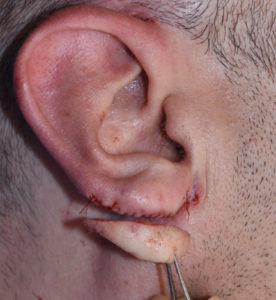The earlobe makes up approximately one-fourth of the vertical length of most ears. Despite its relatively small size it has a greater effect on the appearance of the ear than its size would suggest. The shape of the earlobe changes amongst individuals as well as its size.
The size of the earlobe is affected by many factors including aging, ear ring wear and genetics. Some people have naturally large earlobes while others have their earlobes get longer as they age. This occurs because, unlike the rest of the ear, the earlobe has no cartilaginous structural support. This makes it prone to being stretched like any other skin area.

Reduction of the large or long earlobe helps shorten the vertical length of the ear. It is often part of macrotia reduction as the bottom half of the procedure. Because the long earlobe is often associated with aging, earlobe reduction can sometimes be considered an ear rejuvenation procedure.
Dr. Barry Eppley
Indianapolis, Indiana


